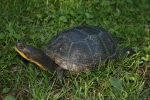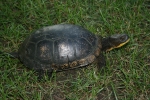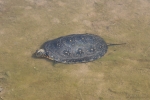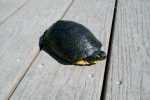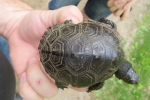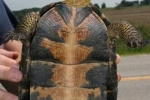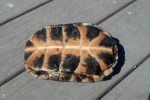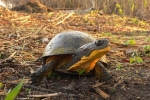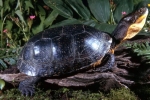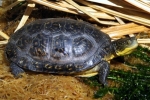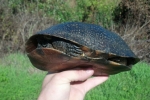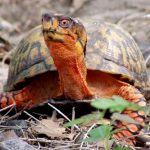Blanding’s Turtle
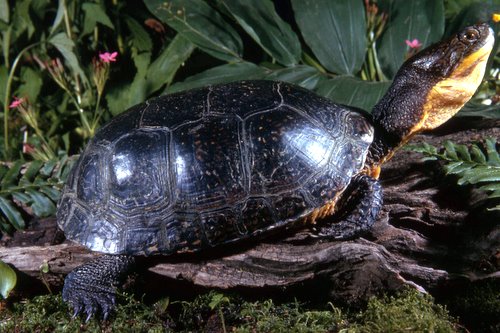
Scientific Name: Emydoidea blandingii
Size: 6-11 inches (15-28 cm) in length
Status: Candidate Species
PAHERP Resource: Have you seen me? Blanding’s Turtle
Habitat:
Poorly drained lowlands, marshes, wet meadows, ponds, and slow-moving streams.
Description:
Medium-sized semi-aquatic /aquatic species. The upper shell is black often with a blue sheen and may have random small yellow markings. The underside is yellow with black blotches. The legs are gray to black, often with a blueish coloration and can have yellow to orange speckling. The underside of the neck is bright yellow. The shell is smooth on top and on the edges.
- The carapace background color is dull black to blue-black and covered with many small irregular yellow to tan spots or slightly radiating lines. Some individuals are patternless.
- The plastron background color is yellow with large black blotches that originate on the posterior lateral surface of each major scute.
- The legs and tail are blue-grey to blue-black with an occasional yellow pigment on the scales.
- The head is blue-black on the top and sides and may have brownish streaks.
- The chin and throat are bright yellow.
- The jaw may be marked with dark bars.
- Medium-sized semiaquatic/aquatic species.
- Side View – The carapace is low in profile and lacks a keel.
- Above View – The carapace is oblong and has smooth margins.
- The carapace surface is smooth.
- The plastron is large and attached by ligaments; not a bony bridge.
- The legs are well-developed and the feet are webbed.
- The head is large and flat on top, and the neck is long.
- The tail is short.
- Side View – The carapace is very low in profile.
- Above View – The carapace is almost circular.
- The carapace is black and lacks spots.
- The head has yellow dashes and short lines on either side.
- The plastron is yellow along the border with a larger dark central blotch.
- The tail is long and slende


References:
- Hulse, C. and McCoy C. J. and Ellen Censky ,1998. Amphibians and Reptiles of Pennsylvania and the Northeast. 222-225pp.
- Ernst, Carl H. and Lovich, Jeffrey E., and Barbour, Roger W. ,1994. Turtles of the United States and Canada. 240-249pp.
- Tom Diez
- Jeff Hankey
- Don Becker (psychoticnature.com)
Heads up!
Please contribute your observation of this and other herps to the Pennsylvania Amphibian and Reptile Survey. Your help is needed.
